As the vine is developing incredibly quickly with the new warm days, Paolo Basso went to meet the winegrowers of Bordeaux to discover the vintage 2014 still in the barrels, but also take stock of the efforts all have made over the last decade to improve their wines, their terroirs, their estate.
Many winegrowers have indeed measured the need to keep Bordeaux at the height of its reputation in front of the increase in quality of other producing countries, but also to meet the markets demand for more accessible wines, easier to drink. This subject has often been heard in the conversations during Paolo Basso's visit at the producers'. Everyone's will to give the nature back what it provides them being more respectful for the environment also appears in filigree.
We all know Paolo Basso has been crowned Best Sommelier of the World two years ago, we less know that he is all the more an expert in Bordeaux wines that he worked part of his carreer for a merchant of fine wines from Bordeaux in Switzerland.
Crisscrossing the vineyards of Bordeaux, follow the expert!
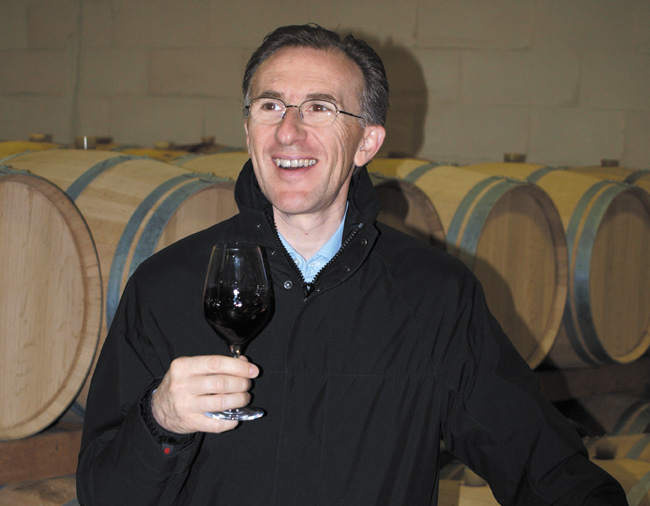
Grand Enclos de Cérons is a 30-hectare domain in the Graves area. It has been taken over by two men who grew up in the wine world Giorgio Cavanna and Bertrand Léon. Giorgio, born in Rome, spent a lot of time with his father in the latter's wine estate in Tuscany. They were advised and trained to quality wine by French enologist Patrick Léon, Bertrand's father, from 1980. Bertrand also is trained enologist and then took care of the family estate in Fronsac.
The Grand Enclos vineyard takes advantage of ideal natural conditions. It essentially lays on 6 to 7 meter-deep gravels. There is limestone in some places. “In very hot years the vineyard resists very well”, Giorgio confirms.
From 2000 works are undertaken to restore the sleeping beauty. Giorgio explains: “We have done something sober but qualitative.” The red wine barrels have been settled in the old rubble stone cellar which is well-aerated. The vathouse has been equipped with thermo-regulated frustoconical tanks. Large for the red, they are smaller for the white and rosé wines, and are worked plot by plot. The work in the vineyard and the cellar is painstaking. “We love to see the terroir's genes, see what it gives best”, Giorgio and Bertrand confirm in a same voice. The vines for the white wines are quite old (35-70 years, the heritage of the old sweet wines) whereas those for the red wines have a better progress margin (35 to 45), “the age of the vines for the red is an area of improvement.”

“For the white wines we are traditionalists. When we started there was a high proportion of Semillon but observing the market, we had to re-balance with Sauvignon.” Bertrand specifies they have always wanted “to keep the parity between Sémillon and Sauvignon but they favour Sémillon”, they consider to be their distinctive heritage. They stir the lees on wheels to avoid opening the bungs. The elevage is done in classic Bordeaux barrels but also in 600-litre barrels for the Sémillons since a few vintages for a more melted woodiness. “We have always seeked freshness.” The picking of the white grapes even takes place by night or early in the morning. The Sémillon is aged in barrels and the Sauvignon in tanks. “Here we produce fine Sauvignons, not those that smell bellpepper or boxwood”, Giorgio confides.
“These strict requirements in respecting the terroir are also true for the red wines. We craft red wines with a majority of Cabernet. The challenge is to get a ripe Cabernet. It is not that easy in Bordeaux.” The red wines spend 12-15 months in oak barrels.
Paolo Basso's visit has been a nice opportuniry to present the range of Grand Enclos: 2010 and 2012 for the dry white Graves; 2006, 2009, 2010 and 2011 for the red Graves.
The prestige cuvée is rightly called Elixir, stemming from a drastic selection of the oldest vine stocks and of the grape with maximum six bunches per stock, thinning-out of the leaves on both sides for a riper material, and integral vinification in new oak barrels for the red wines, with more new barrels for the white Elixir than Grand Enclos, “with no commercial compromise”, a fine wine to lay down. They produce this wine only in the good years and at only 1,000 to 1,500 bottles. “We do not craft 'contest' wines. This wine is an intelectual exercise and a quest for the limits of the terroir.” Paolo was presented the 2012 white and the 2010 red that he described as grand wines.
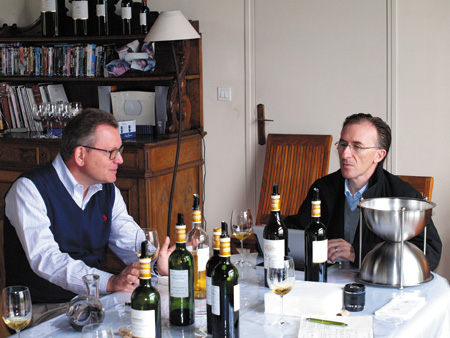
The second wine, Château Lamouroux, exists in red and white Graves and Bordeaux rosé. A wine to enjoy earlier “as we are challenged by the market that demands ready-to-drink wines to enjoy young and from the opening of the bottle.” A topic on which Paolo Basso agrees with him: “It is the current debate: educate or follow the market.”
At last, the treasure of the estate, the Cérons, a botrytised sweet white wine that has no reason to envy the greatest Sauternes. 100% Sémillon from 55 to 70-year-old vines, it is produced at 2 or 3,000 bottles. “The estate was famous for this wine and only produced sweet wines”, Giorgio tells.
Grand Enclos' fine wines are to be discovered, they have a great ageing potential, at least 10 years for the white wines. Forget the sweet wines in the cellar and for the red one, also take your time as “10 years are necessary to get the velvet”, Giorgio confides.
In the nose, scents of citrus, grapefruit, beeswax, mild spices. Beautiful first taste with character, willowy evolution, beautiful savoury note in the mid-palate, a delicate character, a medium intense finish.
Graves, rouge, 2010Pleasant nose with scents of blackcurrant, blackberry, and a lovely note of raspberry jam. On the palate, the wine is rich and expressive, good density and depth, important structure, plenty of savoury, fine although young tannins. Persistant aftertaste.
This 19th-century estate, disappeared in 1945 after the phylloxera, the wars and the crisis of the 20th century, is purchased by the Perrin family and improved from the late 70s. Since 2004 it is managed by Marie José Perrin and her husband René Leriche with the help of their operation manager and enologist David Château.
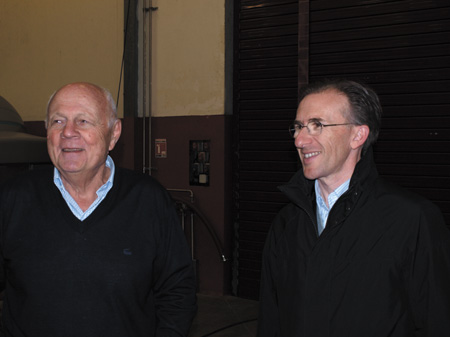
Château Le Sartre takes advantage of the whole range of terroirs of the AOC Pessac-Léognan. The 36-hectare domain is divided into two big ensembles: 26 hectares around the château with gravelly soils on a clay and limestone subsoil; a bit more than 7.5 hectares a kilometer further and 1.5 hectare close to Carbonnieux where the vines are rooted in Garonne alluvia. Thanks to a soil survey and reorganisation its terroirs enable Château Le Sartre to get the best of the Pessac-Léognan typical grape varieties with a majority of Cabernet Sauvignon and Merlot for the red wines, and Sauvignon Blanc and Sémillon Blanc for the white ones.
“We wanted to give priority to quality”, René Leriche explains, and one of the main objectives is to produce red and white wines worth ageing. In the vineyard, the work is extremely precise, with an integrated farming method, plot by plot. Since 2005, the grapes are hand-picked in crates to avoid crushing and keep the integrity of the berries. The varieties and plots are vinified seperately. For the white as for the red wines, all is done to express the purity of the fruit, keep the freshness, and for the red wines, get supple tannins. The white wines are blended usually with 90% Sauvignon and 10% Sémillon; the red ones with 60 to 65% Cabernet and 35 to 40% Merlot.
As a guarantee for good ageing, bottling is subcontracted to the best specialists able, amongst other things, to bottle by inerting with nitrogen, and since 2012 the corks are tighter to increase airtightness. “We work a lot on the cork problem as we think this traditional stopping is unequalled”, David Château explains.

For the barrels, “every year we organize a day of tasting for the coopers. It is a blind tasting and we give a mark following a specific scale. This enables to validate or change the providers and conditions.” Each year this ground work leads to the renewal of one third of the barrels on average, the new ones being selected carefully so that the wines benefit from a traditional élevage in wood without losing freshness.
In May Marie-José and René Leriche welcomed Paolo Basso for a vertical tasting of Château Le Sartre and submit the different vintages to the Best Sommelier of the World's palate. For the white wines, Château Le Sartre 2009-10-11-12 and for the red, Château Le Sartre 2005-06-07-08-09-10-11-12. The opportunity to show the work of a decade and the progress made thanks to investments and the enthusiast professional team beside Marie José and René Leriche.
Classical nose with a lovely complexity with notes of ripe cherries, ripe blackcurrant, graphite. Beautiful well-structured palate, rich and savoury, with a pleasant sweetness and well-balanced by the right freshness. Plentiful firm tannins with a good length.
Notes of passionfruit, pineapple, mango and sage. Excellent first taste with a sweet touch, a beautiful tasty structure with a pleasant astringency, more discreet aftertaste. Very expressive and pleasant.
After the Graves and Pessac-Léognan region, Paolo Basso went to the Sauternes area to meet Corinne Michot, AXA Millésimes communication manager, and Pierre Montégut, technical manager, at Château Suduiraut, First Grand Cru Classé of Sauternes. An instructive vertical tasting, but also a source of emotions as they finished with the vintage 1964.
Château Suduiraut, classed First Grand Cru Classé in 1855, is one of the jewels of the appellation whose sweet white wines are probably of the most famous worldwide. The estate took the name of Suduiraut in the 16th century on the marriage of Nicole d’Allard to Léonard de Suduiraut. Plundered and burned down during the Fronde insurrection in the middle of the 17th century, it is rebuilt by a nephew of the Suduiraut family, Jean Joseph Duroy. The family home then acquired a cartouche featuring the Suduiraut and Duroy coats of arms, which was to give rise to the escutcheon used by Château Suduiraut today. AXA Millésimes acquired Suduiraut in 1992 with the aim of preserving the heritage and maintain the wine in excellence, always aiming at perfection.
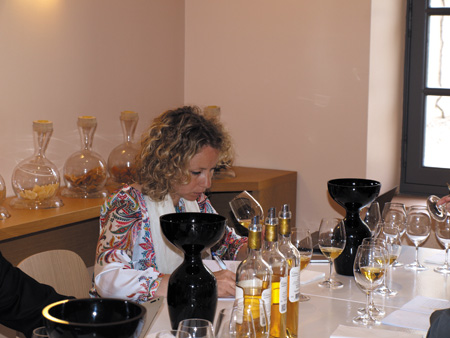
The art of Sauternes crafting depends on the control of the noble rot, Botrytis Cinerea. This fungus present on the grape as from the blooming develops on the berries during the maturation. The alternating morning damp and hot days enable the fungus to turn into the famous noble rot that will concentrate the grapes. The nearness of Suduiraut with the Ciron and Garonne rivers is particularly favourable to its appearing thanks to the morning mist of the early autumn and the hot days of the late summer. Then the meticulous harvest comes with up to five inspections in the rows; then slow pressing to express the complete richness of the aromas. At last vinification and barrel élevage for 18 to 24 months will turn the precious juice into the golden wine.
On a sandy and gravelly soil of 92 hectares, Suduiraut's terroir is ideal for the Sémillon (90%) and the Sauvignon (9% Gris, 1% Blanc). Excellence at Suduiraut lays in the high density (7,000 stocks per hectare), the old vines (30 years on average), integrated famring, low yields (15hl/ha). At Suduiraut the quest for perfection is an obsession. As from 2004, Pierre Montégut implemented plot by plot selection. The wines gained purity.
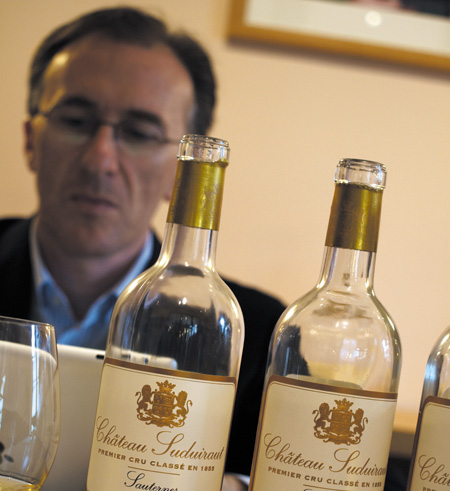
Suduiraut's grand wine, with an exceptional ageing potential, stems from the most prestigious terroir. The requirements are such that some years of lower quality, it is not produced. But it is supported by his young brothers: Castelnau de Suduiraut and Lions de Suduiraut. More approachable in their youth, they stem from specific plots with their own blend. These are perfect wines to be introduced to the grandness of Sauternes. And there also is an elegant and refined dry white wine, S de Suduiraut.
Paolo Basso has been welcomed in the Aroma Workshop so called as there you can find demijohns containing nine aromas often present in Suduiraut's wines. The vertical tasting offered a return in the past from 2011 to 1964. This journey enabled to compare the vintages, but also the stages of development according to the age of the wines and to the main changes in the château. All the aromas of Château Suduiraut could be revealed to the palate of Paolo Basso. Suduiraut's style is characterised by the richness of the aromas, the minerality, the freshness underlined by a hint of acidity, sometimes bitterness in the aftertaste. Mango, pineapple, saffron, mild spices, then honey, aniseed, beeswax, notes of roasted peach, tart...
express in a beautiful rich structure with a great delicacy and a lovely complexity.
The magic of Sauternes has worked again. An encounter at the doors of perfection, warm and friendly, that ended with a dinner in the majestic setting of the château.
Candied mandarin, jasmin blossom, butter biscuits, excellent aromatic complexity that starts melting. Rich, well-structured, the sugar is well-balanced by the acidity, very tasty. Intense and expressive long aftertaste, beautiful character. A great achievement.
Candied mandarin, jasmin blossom, butter biscuits, excellent aromatic complexity that starts melting. Rich, well-structured, the sugar is well-balanced by the acidity, very tasty. Intense and expressive long aftertaste, beautiful character. A great achievement.
Second day in the vineyard for Paolo Basso. He is awaited at Château Destieux by owner Christian Dauriac. He is someone surprising with a peculiar path. His father was a wine merchant and owned Château Poulvère in Monbazillac. He used to sell wines from Destieux that then was a cooperative cellar. “When he died, we sold all.” And Christian Dauriac's mother pruchased Château Destieux in 1971. Although he is trained medical biologist, Christian was asked by his mother to come and vinify his first vintage in 1976. It was a real revelation. He then studied enology and ampelology, thus getting a double skill. It is at that time that he met Michel Rolland who became his friend and closest consultant at the Dauriac Vineyards. Christian Dauriac lives a double life: doctor chairing a network of laboratories and enthusiast wine tailor. In 1984 he purchased Château Montlisse, Grand Cru of Saint-Emilion, and in 1996 Château La Clémence at Pomerol.
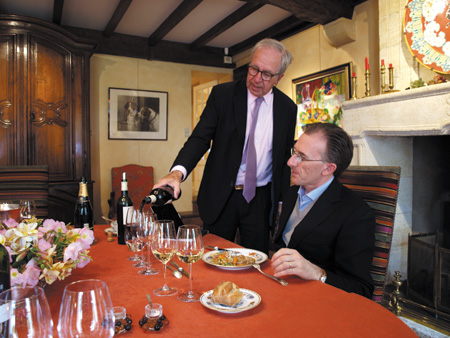
Grand Cru obliges, Destieux' wine is finely crafted. In the vineyard Christian Dauriac can rely on Michel Duclos, France champion of pruning. The latter manages the 8 hectares with integrated famring processes. Destieux' terroir perches on the second highest pont of Saint-Emilion and consists of clay and limestone terroirs with a thin siliceous vein surfaces in the highest points of the vineyard. The cellar is the place where enologist Laure Ininger strives. The vathouse has 8 tanks. “On the 8 hectares, I distinguished 23 crus, I identified the stocks and made 8 ensembles”, Christian Dauriac explains. In a 30-year time, he managed to improve the quality and in 2006 Château Destieux was ranked Grand Cru.
Christian Dauriac's passion does not stop at the doors of Saint-Emilion. He owns a property in South Africa, Marianne Wine Estate. There he vinifies as in Saint-Emilion and manages to make wines that age well. “We have found an exceptional terroir with 45% clay. With Michel Rolland, we make Bordeaux-style blends and varietal wines, then wines for the African market.” For high end wines, the South-African market has to be educated. Christian Dauriac created brands that work well locally to support the prestige range. “We have reach financial balance at last but I sent money for ten years,” he says in a smile.

A real help has been the celebration of Nelson Mandela's 90th birthday in London in 2008. The sommelier of starred Gordon Ramsay in charge of the dinner issued a call for tenders that was wno by Marianne with the cuvée Floréal and the Sauvignon Blanc. “I have become the Mandela Wine and Marianne has become a flagship estate in South Africa. The Mandela foundation has bought what remained of the vintage.” The year before Marianne had been elected Best Shiraz 2007 by the Michelangelo Wine Awards.
The visit of international Paolo Basso turned the tasting into a gustatory journey from Saint-Emilion to Stellenbosch: Château Destieux 2010 and 2001, Château Montlisse 2011, Château La Clémence 2010 and 1998. Then the Marianne wines: Selena 2011, Cape Blend 2009, Pinotage 2008, Merlot 2008, Cabernet 2008, Syrah 2008, the cuvées Desirade 2005, Floreal 2006 and L'Escapade 2012. A beautiful encounter of two wine enthusiasts.
Aromatic herbs, liquorice, vanilla, mild spices, cassis liqueur in the nose. Beautiful first taste, rich and voluminous; great structure and elegance, tasty; round and juicy tannins, persistent and intense aftertaste with notes of spices and vanilla. Aerate half an hour before service. A really grand wine.
In the nose, scents of leaves, mushrooms, forest fruits, tobacco. Beautiful traditional and round palate, melted, complex. Beautiful flavours and an intriguing length supported by a lovely powerfulness. A beautiful wine. Very expressive.

Leaving Saint-Emilion, Paolo Basso made a short stop in the Graves area at Domaine de Chevalier. Welcomed by Olivier Bernard, he could taste Domaine de Chevalier red 2014, but also the range Clos des Lunes, a celestial cuvée created by the Bernard family three years ago.
Olivier Bernard, at the head of 60 hectares at Domaine de Chevalier, pursues since his arrival at the château in 1983 the quest for excellence started by his forebearers in the 19th century. It led him to the Sauternes region where the family runs 45 hectares of vines at Clos des Lunes. On these lands where the golden wine, Sauternes, stems from, “botrytis only settles on excellent grapes. Our challenge is to harvest before it comes.” Olivier Bernard managed to prove grand dry white wines could be produced here.

Clos des Lunes exists in three versions: Lune Blanche, Lune d'Argent and Lune d'Or. Olivier Bernard relies on the winegrowers who take care of he vineyard up to the thinning of the leaves. For the green harvest, summer works, harvest, the team of Domaine de Chevalier takes over the vineyard. As much care is taken for the vinification than for the wines of Chevalier. Clos des Lunes is hand-picked in crates, in the morning and like for the famous sweet wine, the harvesters can control 5 to 6 times the raws to pick berry after berry, at perfect ripeness. Lune Blanche is matured in tanks, it is a wine for immediate pleasure; Lune d'Argent is aged at 25% on the lees and Lune d'Or, the very essence, is aged at 100% in oak barrels. The 180,000 bottles produced have all been sold within 2 weeks. “After only three vintages, we are very proud of the result,” Olivier Bernard is pleased to state.
Lovely nose, very complex, tropical fruits and quality élevage. Lovely pleasant and savoury first taste, lovely body, quite long-lasting and pleasant aftertaste. An interesting wine.
Beautiful nose, fine French woodiness, citrus and smoky side. Good material supported by a vivid acidity, wonderful long aftertaste. A very fine wine.
— www.domainedechevalier.com —
— www.closdeslunes.com —
"When I took over the domain in 1993 I hired an excavator and I destroyed the operation buildings and part of the vathouse!” That is how Philippe Rénier started his history at Château Fontbonne. He took over the family domain from his mother. A professional shift for him as the activity of Fontbonne, where he grew up, being divided between livestock and winegrowing, Philippe first chose to become a … butcher by passion! The crop still exists and is fed in the surrounding fields. An ecological richness that Philippe tries to preserve. He stopped chemical weedkilling and very reasonable phytosanitary treatments.

The domain totalled 10 hectares in 1994, Philippe now is at the head of 32 hectares in the AOC Bordeaux, a quality terroir that stretches between Faleyras, Blasimon and Ruch. From 1995 to 2000, Philippe completely reorganized his vathouse and barrel cellar to improve the quality of his wine he started selling in bottles.
Philippe admits that because of the powerfulness of his red wines, he has “has to wait before marketing them”. Mainly Merlot, they are nicely fruity, with a good tannique structure that need to melt.
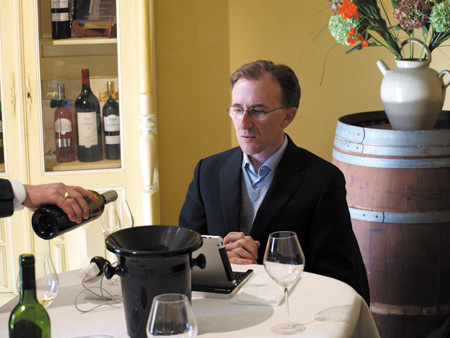
For his white wines, Philippe chose to work with Sauvignon, although the “consumers fear the Sauvignon as many Bordeaux wines are too acid for them”, he confides. A challenge he successfully took up as his wines are regularly awarded at the French and international contests.
His range is composed of Château Fontbonne in red, white and rosé, the cuvée Henriette in white, the cuvée Marie as well as Edouard de Fontbonne in red. To present the result of these years of rebuilding and efforts, Philippe invited Paolo Basso to taste his wines. An encounter under the sign of quality, sympathy and conviviality, without pretention nor frills, just like Château Fontbonne.
In the nose, notes of laurel, mint, eucalyptus, ripe cherries. Beautiful full and warm first taste, increasing development, full-bodied with a rustic side, slightly dry tannins. Beautiful tasty finish.
Beautiful fruity ripe nose, mint, a hint of eucalyptus. On the palate, rich and concentrated, a beautiful structure. A bit strict tannins. A beautiful wine with a masculine character.
Second Grand Cru Classé of Margaux, Château Lascombes is settled at the heart of the village of Margaux. Paolo Basso was awaited for a vertical tasting of the grand wine and a lunch with Dominique Befve, Karine Barbier in charge of the communication, and Delphine Barboux, enologist.

Château de Lascombes lies on a 112-hectare vineyard in the appellation Margaux and 6 hectares in Haut-Médoc. The estate benefits from very sought-after soils in Margaux that are divided in equal part between gravelly hills for the Cabernets Sauvignons and Petit Verdot (5% of the total planted grape varities), clayey gravels with Merlots and Cabernets Sauvignons, and clay and limestone plots—about 30% of the total surface area—for the Merlot. This specificity makes that Merlot is the dominant grape variety (50%), something quite original for the Médoc.
Between the 17th and 21st century, the history of the château will be marked by several iconic characters who will leave their imprint on its architecture, fame, technical development. The oldest owner ever known was Knight Antoine de Lascombes who rooted the destiny of the château. One of his descendants Jean-François de Lascombes, councillor at the Parliament of Bordeaux, Academy member and King's prosecutor at the Admiralty in 1761, spent his fortune to enhance the quality of the wine. In 1855, Château Lascombes was ranked Second Grand Cru. In 1952, Alexis Lichine, wine merchant, promoted Lascombes over the world.
Last owner, the MACSF group (health professionals insurance) continues since 2011 to keep Lascombes in the sphere of excellence. Since 2001 already, the domain had been taking advantage of the expertise of a man who built up his carreer at Château Lafite-Rothschild, Duhart-Milon, l'Evangile: Dominique Befve. He initiatied the technical renewal of the premises and the modernisation of the vinification. He refined the work on maturity by increasing the number of grape tastings in the vineyard and adapted the varieties to the soils. He equipped the vathouse with more wooden and stainless steel tanks to refine the work plot by plot.
He chose a team with a mosaic of profiles, a richness that nourrishes the excellence of the Second Grand Cru Classé by the passion that drives all these men and women. A young enologist, Delphine Barboux, advised by famous Michel Rolland, a vineyard manager Miguel da Fonseca, native from Douro, who works at Lascombes since 1976, and some forty people who take part with their fervour in maintaining Lascombes at rank.

The very demanding ambition for quality sometimes leads to make difficult choices such as to reduce the volume to support the quality. In the vineyard already, all the work is done by hand. They thin out the leaves and do green harvest. The vathouse is built on four levels to be able to work with gravity and maintain the integrity of the grapes. Of course, the plots and varieties are worked separately in stainless steel and wooden tanks. At Lascombes they operate cold prefermentation (5°C for one week) to get a deeper colour and a better complexity of the aromas. At last, the wines age on the lees in French oak barrels and the château invested in Oxoline systems that ease the turning and handling of the barrels during that stage. The wines stays 18 to 20 months in barrels.
Château Lascombes' wines have all the qualities if the Médoc wines, added with a smooth bouquet and an excellent ageing potential. The big proportion of Merlot certainly is its special feature and results in wines that can also be enjoyed young. The grand wine (300,000 bottles on average) are made to be kept. Those who cannot wait will be delighted with Chevalier de Lascombes (150,000 bottles) that can be drunk within the 10 first years. A Haut-Médoc is also produced (20,000 bottles), suppler, rounder, to drink young.
Hearing about Paolo Basso's visit in the vineyard, Dominique Befve wished to receive him at the château for a verticale tasting (1999-2001-03-05-07-09-11-13-14) and a lunch in the splendid room of the château. The tasting led the Best Sommelier of the World through the main stages of the château's life as the vintages covered the years before and after Dominique Befve, but also after 2011 when MACSF bought the estate. Paolo Basso has undoutedly noted the great complexity of the aromas, the fully open expression, fruity, the rich and slender structure of theses grand wines.
Lovely olfactory expression with notes of mild spices, toast, leather, eucalyptus, ripe blackcurrant. Fresh and tense at first taste, it develops towards a structure of good density with tight tannins and a slender aftertaste with aromas of liquorice.
Neat, open and flattering with scents of ink, blackcurrant liqueur, cinnamon and mild spices. Lovely dense and savoury palate supported by a good acidity, juicy and rich. Firmer tannins in the finish.
The Anney family's roots in the Médoc date back 1678 with a ploughman called Anney. His great-grandson became a winegrower at Saint-Estèphe in 1876 and a few generations later, in 1938, Pierre Anney purchased Château Tour des Termes. Now Christophe Anney took over the reins from his father Jean, Pierre's son, with his wife.
The domain totals 25 hectares out of which 15 hectares dedicated to the production of their grand wine Château Tour des Termes (Cru Bourgeois) and 8 hectares for the second wine Préface de Tour des Termes. The family also owns Château Comtesse du Parc, the historical domain of the family on 9 hectares at Vertheuil in the AOC Haut-Médoc. The range is complemented with Château Saint-Corbian and Château Haut-Paradieu, two Saint-Estèphes.
Château des Termes is mainly planted with Merlot, added with Cabernet Sauvignon, and a hint of Petit Verdot which provides the wine an extra touch of character. “We search for style and finesse”, Christophe Anney explains.
The vineyard is covered with grass between the rows. “We would like to be certified Terra Vitis.” Green harvest is done systematically as “it is better to have low yields and avoid botrytis.” The harvest is mechanical by 80%. “I want to 'dedemonize' the machines. Nowadays they are very efficient.” The team works with vibrating bins as the grapes are less mashed than with an endless screw dumper. The grapes then pass on two sorting tables.
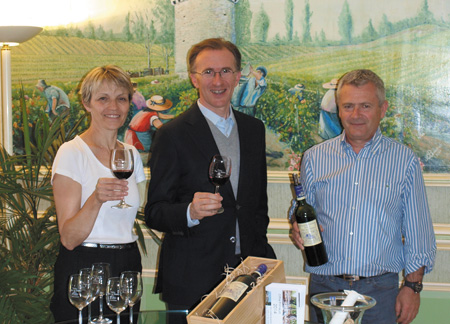
80% of the juices are vinified in double tanks to ease the racking process. Extraction is gentle and avoids to 'overwash' only a small surface area like with usual pumping over. The remaining 20% undergo integral vinification in barrels. All the wines are then aged in oak barrels for 15 months
for the first wine (50% new oak) and 2 or 3 times used barrels for Préface. “Our wine stands out thanks to their ability to age well thanks to very ripe and coated tannins, never aggressive nor harsh.”

As Christophe Anney regrets not to receive enough international tasters, he invited Paolo Basso to get his impressions. After presenting Comtesse du Parc 2012 and Préface des Termes 2012, Christophe Anney prepared a vertical tasting of Château Tour des Termes from 2009 at 2014. A beautiful opportunity to evoke vintage after vintage the difficulties and satisfactions. Like 2013, unequal in Bordeaux, “a race against time” as Christophe Anney says. But it was a good achievement for Château Tour des Termes who thumb their nose to those who criticized the vintage. Or the 2014 that the family really liked to harvest. “We could stagger the harvest”, he tells. This tasting confirmed that Château Tour des Termes is worthy its rank with “non made up terroir wines” as Christophe Anney likes to say.
Beautiful nose with scents of ripe cherries, morello cherries, blackcurrant jam, a balsamic note. Rich and voluminous on the palate with a tight-knit and savoury background, firm and juicy tannins. A beautiful aftertaste without bitterness of medium intensity.
Saint-Estèphe, 2014Typical nose of a wine undergoing élevage, strawberry, raspberry, floral, very pleasant. Rich and voluminous on the palate, an increasing development towards a well-structured, sweet and rich body. An important and juicy tannic material, a beautiful aftertaste with a savoury character. A very good wine.
— www.chateautourdestermes.com —
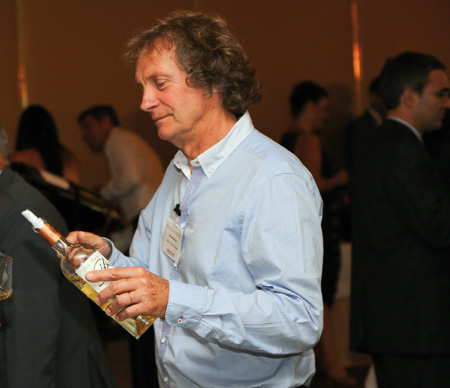
Château Pontac-Monplaisir, in the AOC Pessac-Léognan, can be discovered round the corner of a street, at the heart of the city. A peculiar feature that also is a challenge. The advantage of the château is to have 16 hectares in one piece all around which is convenient in a peri-urban area.
Developed by Jean Maufras, the estate is now managed by his son Alain and grandson Alex who joined the property two years ago. 90% of Pontac-Monplaisir's terroir consists of clay and limestone soils whereas the neighbours have gravels. In the field the vines are handled with the greatest respect for this quality terroir. A first sorting is done on the stock during the harvest. In the cellar the family still works with large concrete tanks that are 80 years old but still efficient! The wines age about 12 months in Burgundy barrels, a type of wood the Maufras chose to get more fruitiness. The difference is perceptible on the white wines as from 2013, thanks to this change and the addition of Sauvignon Gris.
To complement the range of Château Pontac-Monplaisir, the family purchased in 1951 the neighbouring Château Limbourg on three hectares with 1 for the white wines. With a predestined name, Limbourg's wines are mainly produced for the Dutch and Belgian markets. Which is clearly evidenced by the orange label and capsule!

60% of Pontac-Monplaisir's production is sold to the merchants for export, but you can find the Maufras family's wines in cellar shops and the Horeca, or directly at the estate. The estate opens its doors for tasting workshops, artistic and gastronomic events. Its location close to Bordeaux makes it easy to access.
For a short visit on a lovely morning of May, Paolo Basso tasted Pontac-Monplaisir red 2006-07-08-09-10-12 and white in 2011-12-13. They evidence the quality work carried out by the family since several generations that makes of them sure bets in Pessac-Léognan and wines worth ageing.
Ripe blackcurrant, notes of cherry and morello cherry, mild spices, sloe. Rich and voluminous with a lovely warm support, good solid and tasty material, important and ripe tannic mass, beautiful long-lasting and intense aftertaste. A powerful and manly wine.
Young nose with discreet notes of roasted citrus, mango, mild spices. Beautiful tense and quite savoury palate, medium body, delicate with a discreet aftertaste. Beautiful first taste and more reserved aftertaste because of the vintage.
On this lovely sunny morning, Château d'Issan, one of the oldest estates in the Médoc, open the doors to Paolo Basso. A present-day encounter over the new 2014 vintage in a place filled with History.
The viticultural history of the château started in the 12th century when its wine (then called Lamothe-Cantenac) was served at the wedding of Alienor of Aquitaine who married Henri de Plantagenêt, future king of England. In the 18th century, still in England, it was very appreciated. Closer to our times, in the early 20th century, it became the favourite wine of Emperor François-Joseph at the Court of Austria. Then arises the motto of Château d'Issan : “Regum mensis aris que Deorum” - For the table of the Kings and the altar of the gods. In 1945 the Cruse family, merchants from Bordeaux, purchased the château left abandoned despite its former lustre. Now Emmanuel Cruse, Master of Commanderie du Bontemps, manages the estate.
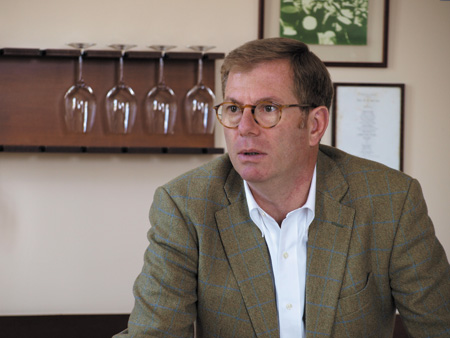
The buildings date back the 17th century and are registered as Historical Monuments, therefore protected. Flanked with to towers, the castle is partially walled, and surrounded with moats crossed by little bridges. A setting that invites for daydreaming and ajourney back in centuries. “As we cannot build anything near the castle, we keep a historical and authentic side” Emmanuel Cruse explains. “Moreover I think the traditional customers of Bordeaux come more for that side than to visit an ultra modern winer.” The 17th century cellar, “the Festival Cellar”, is still used for the press wines that Issan likes to exploit.
Classed 3rd Grand Cru of Margaux in 1855, the domain covers 47 ha around Issan. The road that leads to the château separates the vineyard in two: on one side the vines for the Margaux, planted on gravels, for the grand wines (Château d'Issan and second wine Blason d'Issan); on the other side the vines in appellation Bordeaux Supérieur (10 ha) for a second wine Moulin d'Issan.
Two grape varieties share the stage, Cabernet Sauvignon (65%) and Merlot (35%). Issan's style can be defined as “authentic”. The vineyard is managed in biodynamics, harvest is manual. Issan vignes sont menées en biodynamie, les vendanges sont manuelles. By the way Issan can rely on loyal Danish and French pickers. Vinification is done plot by plot and the wines are aged 18 months in oak barrels with 50% new ones. They are advised by Eric Boissennot.

Through his mission at Commanderie du Bontemps, Emmanuel Cruse is used to promote the wines of this part of Bordeaux. He would like Margaux to seem more open. “I regret that since 2009-2010 the wine has become a speculative product. Wine has become a luxury product whereas it should remain a product for pleasure.” He would like the visitors to come at the château and see the work carried out to understand the prices of the Grands Crus.
Paolo Basso was invited to taste the vintage 2014 of Château d'Issan and Blason d'Issan. “We have been extremyl lucky with this vintage, Emmanuel Cruse explains. The 2014 is a real good achievement in view of the weather conditions. The Cabernets' density helped a lot. We were not nder pressure for the harvest. The 2014 is the best vintage of the 'not exceptional' ones.” He also specifies that “Blason d'Issan is a second wine not by default. We do a real selective work.” Then Paolo tasted Château d'Issan 2012 of which Emmanuel Cruse says it will be a good surprise. “It is a crisis vintage but it will be one of the good years.”
The encounter continued over a a lunch that staged Château d'Issan 2008, 2005 and 2000 with noble dishes worthy the 3rd Grand Cru Classé of Margaux: Lobster, Beef Prime Rib, that remind nonetheless that Château d'Issan is a top-class wine.
Beautiful fruity note, fresh. Aromas of blackcurrant, ink, liquorice and mild spices. Firm, linear and fresh structure, round tannins and delicate aftertaste with a hint of bitterness.
Beautiful note of spices, liquorice, ripe cherries, ivy. Wonderful volume, a savoury and rich wine, full-bodied, with ripe and integrated tannins. More discreet aftertaste marked by freshness that should open with the élevage.
The history of Château Chantegrive started like a fairy tale. Henri Lévêque was a broker and fond of wine. In 1967, he decided to sell his collection of stamps he started when he was 15 to buy two hectares of lands in Podensac. He called the estate Chantegrive [Singing Thrush], a tribute to the colony of thrushes that lived on the terrain. His wife and him bought plot after plot and the château now totals 96 hectares in the appellation Graves.
The surface area of the vineyard is shared in nearly equal parts between white (50% Sauvignon and 50% Sémillon) and red (50% Merlot and 50% Cabernet). Chantegrive's terroir is exclusively composed of undeep gravels on a clay and limestone layer. Close to Cérons and the plateau of Sauternes, the soils are favourable to the production of excellent white wines.
Château de Chantegrive is now managed by the new generation of the family, represented by the founders' five children Marie-Hélène, Agnès, Carine, Patrice and François. Since 2006, they are advised by Hubert de Boüard who made them take a shift in quality, especially for the red wines. They have become more fruity and moreish.
During the harvest, selection starts while picking and continues in the cellar. The grapes benefit from meticulous care to preserve the maximum freshness and fruitiness expected in the wine. The white wines are inerted during a month. The red wines spend 12 months in oak barrels (half new, half used once). “We try to make charming wines, with a good balance between the natural tannins of the grapes and the structure of the barrel”, Marie-Hélène Lévêque explains.
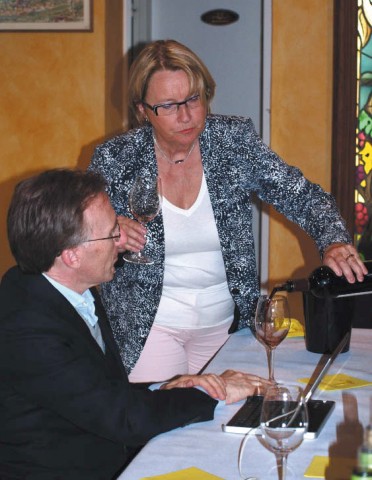
Château de Chantegrive already was the largest estate in the Graves region and strengthened this position in 2015 by purchasing their neighbour Château Madère in Podensac. Planted with Sémillon, this 12-hectare vineyard consolidates the production of white wines, especially the cuvée Caroline, as the current volumes are not enough to face the demand.
In May the family received Paolo Basso at the château. He was surely touched by the vivid sympathy they arouse by their warmth and sense of hospitality. Above all, wine means sharing, and the Lévêques do it well as evidenced by the Chantegrive Prize whose 13th edition took place in June. It rewards students of the Hotel and Catering Business School of Talence for the best food and Chantegrive wine pairings. It also is the school of Talence that prepared the dinner for Paolo Basso.
Paolo's visit to the Lévêque family was the last of his tour in the vineyard of Bordeaux. As an introduction, Marie-Hélène prepared a vertical tasting of Château de Chantegrive white (2001-09-10-11), Cuvée Caroline (1997, 2007-12-13-14) and Château de Chantegrive red (1985, 90, 99, 2000-01-02-09-10-11-13-14). The dinner with the family that followed carried the guests in a journey from the Graves to Saint-Emilion, native place of the family, to Argentina where Marie-Hélène's brother Patrice invested in a domain in Mendoza with his wife Hélène Garcin (Château Barde-Haut, Grand Cru Classé of Saint-Emilion).
Beautiful aromatic complexity on spices, ivy and liquorice. Fresh and dynamic first taste, tight tannins, delicate aftertaste with a hint of bitterness.
Nettles, passionfruit, blackcurrant buds. A beautiful first taste, good body, delicate finish. Wonderful at first taste.
Sylvia van der Velden